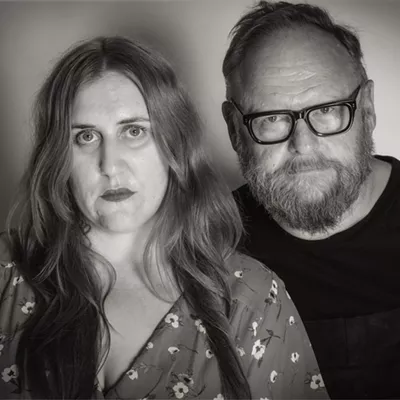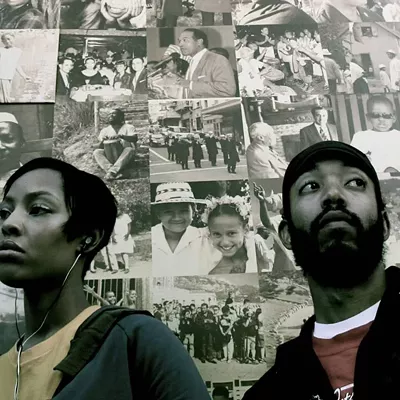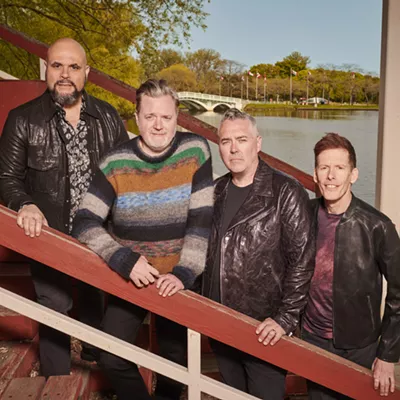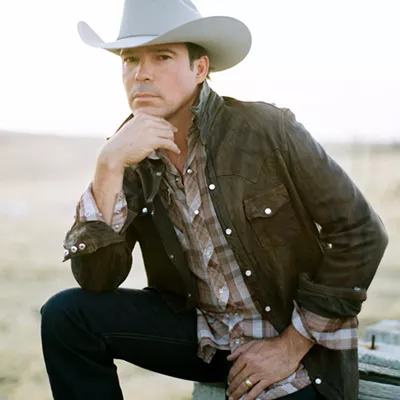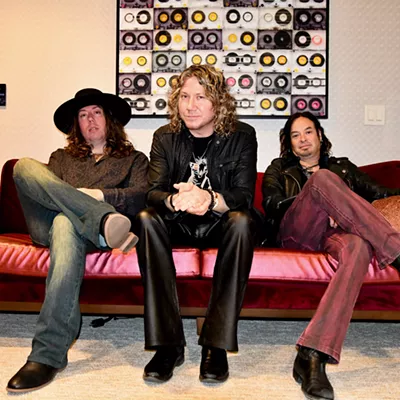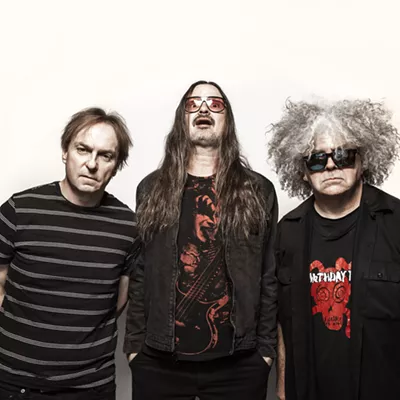These are just a couple of stories locals the Okmoniks shared about their local predecessors; there's also the legend of Charles Schmidt, whose fame as a rock-and-roll serial killer (he strangled girls with guitar strings) landed Tucson in Life magazine, with a photograph of Speedway Boulevard in its sprawled-out glory. Conclusion: ugly desert town + ugly rock and roll music = ugly evil serial killers. Rock and roll had it hard in the early years.
These days, rock and roll doesn't have it so hard, and Tucson's a low blip on the national music radar, but there are several bands here that are starting to make that blip bleep: the Okmoniks are one such band. Sixties-inspired garage rockers who practice not in their garage but in the back of the house (a onetime motorcycle shop) where they all live together in happy harmony, the band members know their rock and roll history and use it well.
"We covered some of those people, we're really proud of the Tucson '60s rock and roll," said singer and organ player Helene 33 (as in 33 1/3 rpms).
"Tucson just really had a pretty rich history. Well, not for the last 40 years. Until us," added guitarist Sammy.
The Okmoniks, who call themselves "Tucson's No. 1 party band," have good reason to be fairly cocky; while they may not be a household name here in town, you can find an Okmoniks song listed on several college rock station playlists across the country (in places where they have college stations that people can actually listen to). Tons of people in San Francisco and Los Angeles show up to their shows. They've played with the Seeds. And the people who played in garage bands in the actual '60s show up to Okmoniks shows and profess their undying love.
"They really really like us but they're all celebrities," said Sammy. "We're superstars."
"Superstars" who still call Tucson home. Helene 33 and Sammy are both students at the University of Arizona, Justin rose up through the music scene ranks from door guy to fan boy to roadie to drummer, and bass player Trent you may recognize from an area record store and numerous other bands he's played in. The Okmoniks began when Helene 33 and Sammy decided they wanted to form a New Wave band, but once they found an old Hammond Sounder organ, the real Okmoniks sound was born.
"When we were starting off as New Wave we liked the organ, keyboard sound," said Helene 33. "But we had started listening to a lot of music from the '60s, like the Animals and other bands with organ in it, and so we knew that was the next step. It was catchy like New Wave but it sounded a fucking lot better."
Said Sammy, "We always had a Casio keyboard."
"A stupid electronic keyboard," said Helene 33. "We found this Hammond Sounder for $20 and we totally mutilated it, we cut off the bottom half of it..."
"It was like a church organ," interrupted Sammy.
"And quartered it and made it into this tiny little thing and painted it red," Helene 33 finished.
"And what further helped is we're all into the same music now, which is really unusual for a band. I know all these old guys that my parents have always been friends with who would say, 'Yeah, if you're in a band, the most important thing is everybody else loves the same music,'" said Sammy.
The love of '60s garage rock is the glue that holds the Okmoniks together. Sammy's messy guitar jangles along behind the organ and vocals, which carry the simple melody lines; basic rock and roll, complete with a breakdown. When they play live, they all smile like the goofy fun-loving rock and roll kids that they are. Sammy, Trent and Justin all focus on Helene 33, who manages to dance, sing, hold the microphone and play organ all at once, while wearing the coolest mod outfits this side of the British Invasion.
"I think an important thing about the forming of the Okmoniks is that there haven't been a lot of girl bands that have done '60s rock and roll or even punk, really," said Sammy. "I mean, there's a couple. Rock and roll has always been somewhat male dominated. We were really interested in producing a sound that's never been done by women before, which is pretty much true for us."
Helene 33 said the band's songs are "all about me hating other girls."
Sammy expanded on that theme. "I write songs for her point of view, so I write songs about her being jealous of her boyfriend hanging out with other girls," Sammy said. "Or her wanting to kill another girl. Ever since we were teenagers in a band I always liked these kinds of teenage love and hate, young kid rock and roll themes."
"What's also weird about our songs is that Sam writes them, but they're very organ-centric," said Trent.
"Sam writes them; Trent rocks them," added Justin.
"We're just trying to do fucking rock and roll. With an organ," said Sammy.
The Okmoniks have released two 7-inch recordings: Take a Spin with the Okmoniks came out in January 2002, and Rustle Up Some Action with the Okmoniks was released this past January. They have a cassette, Video Game Attraction, coming out soon, and plans for a full-length record in the works, when they can afford it. After a few more shows around town, they're taking off for a midwestern tour; in Chicago, they'll be a part of a children's dance show called "Chic-a-go-go," which features lots of cool bands performing live and a "puppetronic rat host" named Ratso.
For some strange reason, the Okmoniks are sort of embarrassed about the origin of their name. All Sammy would say is, "If you were alive in the '80s and watching bad television, you'll know." So the Okmoniks' anachronism isn't limited to the '60s; in their house, decorated with records and bright colors, they also have a two-player tabletop Ms. Pac Man game from the '80s, and Helene 33 and Sammy are both huge video game geeks.
"Here's an interesting fact about the Okmoniks: Three out of the four of us have the best record collections in town," said Sammy.
"One out of the four of us has a monkey suit," said Helene 33.
"Two out of four of us are really hairy," said Trent.
"Three out of four of us have boobs," added Helene 33.
"Shut up! Everybody shut up!" said Sammy. "I have the best video game collection in the United States."

